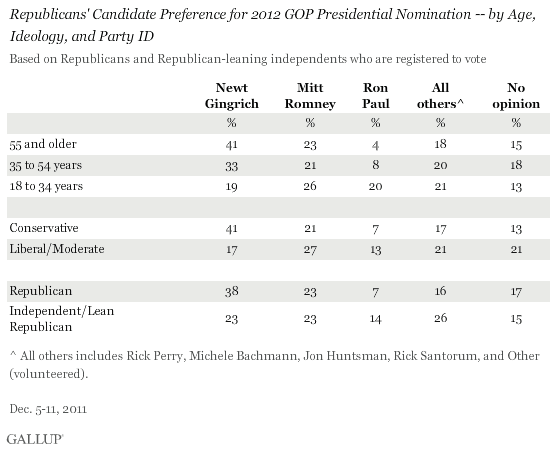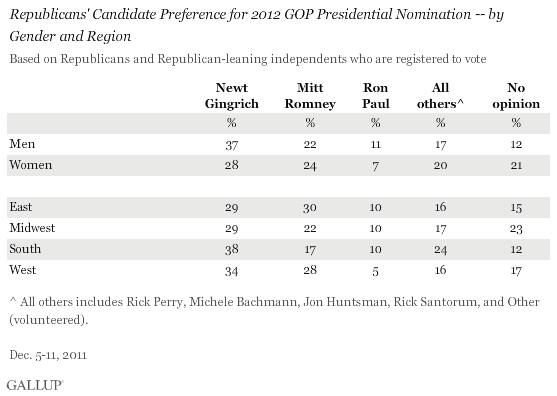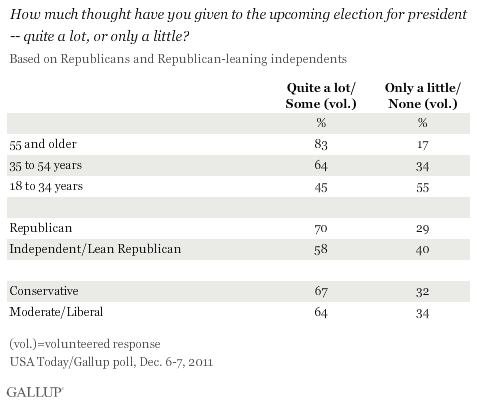PRINCETON, NJ -- Newt Gingrich's current lead in Republican preferences for the GOP presidential nomination is largely attributable to particularly high support from the types of Republicans who might be expected to turn out heavily in the upcoming primaries -- older Republicans and core identifiers with the Republican Party. Roughly 40% of Republicans aged 55 and older as well as core Republicans (as opposed to independents who lean Republican) and conservatives currently favor Gingrich for the nomination. This contrasts with 21% to 23% of each group backing Mitt Romney.

Gingrich also leads Romney among those 35 to 54 years of age. Romney leads among young Republicans, aged 18 to 34, but, at 26%, is only slightly ahead of Gingrich and Ron Paul among this group, with both receiving close to 20%.
These results are based on interviews with 1,665 Republicans and Republican-leaning registered voters in Dec. 5-11 Gallup Daily tracking.
Overall, Gingrich led Romney by 10 percentage points during this period, 33% to 23%, with 9% backing Paul and 6% each backing Rick Perry and Michele Bachmann.
Gingrich also enjoys a solid lead over his opponents among men and Republicans in the South. He narrowly edges out Romney among women and in the Midwest and West, while he ties Romney in the East.

The significance of the older, more Republican-oriented nature of Gingrich's support base is that these groups traditionally turn out to vote at higher rates than their younger, more independent counterparts. This is reflected in the self-reported "thought" that various subgroups of Republicans currently say they are giving to the presidential election. According to USA Today/Gallup polling conducted Dec. 6-7, 83% of Republicans aged 55 and older say they have given quite a lot or some thought to the election, almost twice the level recorded among those aged 18 to 34 (45%).
A somewhat smaller, but still sizable, gap in attention to the election exists between those identifying themselves as Republicans and independents who say they lean toward the Republican Party, 70% vs. 58%. At this stage, Gallup does not see a marked difference in attention to the election between conservative Republicans and moderate/liberal Republicans.

This "thought" question is a key component of Gallup's multidimensional likely voter scale used in the last month or two of election years, and, when asked in isolation, provides some sense of which groups are likely to turn out at higher rates than others.
Implications
Gingrich's newfound position at the top of national Republican preferences for the 2012 GOP presidential nomination is far from secure. In addition to the opportunity for campaign slip-ups between now and the Iowa caucuses in January, Gallup's continuous five-day rolling averages of Republican preferences recently show Gingrich's lead over Romney dropping from 15 points in tracking from Dec. 1-5 to 8 points in tracking from Dec. 11-14.
Still, Gingrich may have a special advantage in the types of Republicans who are attracted to his candidacy. Older Americans and partisans (both Democrats and Republicans) are typically more likely to turn out in general elections than younger voters and independents, and that pattern is seen in recent Gallup polling on Republicans' attention to the 2012 campaign.
Thus, even if Gingrich is tied with or a little behind Romney in surveys of Republican registered voters in various states by next month, he could theoretically still win those primaries on the basis of turnout. Romney and Paul, on the other hand, may be handicapped by the current skew in their support from younger voters and independents who lean Republican -- groups that don't currently appear to be as interested in the election.
Survey Methods
Results are based on telephone interviews conducted as part of Gallup Daily tracking Dec. 5-11, 2011, with a random sample of 1,665 Republicans and Republican-leaning independents who are registered to vote, aged 18 and older, living in all 50 U.S. states and the District of Columbia.
For results based on the total sample of Republicans/Republican leaners, one can say with 95% confidence that the maximum margin of sampling error is ±3 percentage points.
Interviews are conducted with respondents on landline telephones and cellular phones, with interviews conducted in Spanish for respondents who are primarily Spanish-speaking. Each sample includes a minimum quota of 400 cell phone respondents and 600 landline respondents per 1,000 national adults, with additional minimum quotas among landline respondents by region. Landline telephone numbers are chosen at random among listed telephone numbers. Cell phone numbers are selected using random-digit-dial methods. Landline respondents are chosen at random within each household on the basis of which member had the most recent birthday.
Samples are weighted by gender, age, race, Hispanic ethnicity, education, region, adults in the household, and phone status (cell phone only/landline only/both, cell phone mostly, and having an unlisted landline number). Demographic weighting targets are based on the March 2010 Current Population Survey figures for the aged 18 and older non-institutionalized population living in U.S. telephone households. All reported margins of sampling error include the computed design effects for weighting and sample design.
In addition to sampling error, question wording and practical difficulties in conducting surveys can introduce error or bias into the findings of public opinion polls.
For more details on Gallup's polling methodology, visit www.gallup.com.
